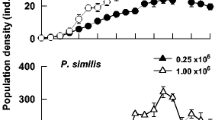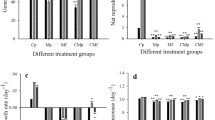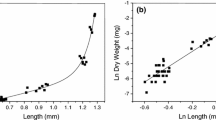Abstract
Mercury is highly toxic to a variety of aquatic organisms including zooplankton. The functioning of freshwater ecosystems can be altered if rotifers, being a natural food link between phytoplankton and fish larvae, are contaminated by mercuric compounds. In order to detect age-specific responses of the rotifer Brachionus calyciflorus to mercury toxicity (5 nominal concentrations as chloride viz. 0, 0.000625, 0.00125, 0.0025 and 0.005 mg l−1), we used the standard life table method at two different food (Chlorella vulgaris) levels (0.5 × 106 and 1.5 × 106 cells ml−1). Data indicated that increase in mercury concentration had an increasingly intense negative effect on many of the life history variables, while at higher food levels, its impact was less. A nearly rectangular survivorship pattern was obtained in controls, especially at higher food levels. This trend gradually changed to a steep fall as the concentration of the heavy metal in the medium increased from 0 to 0.005 mg l−1. At any given food density, increase in the mercury concentration resulted in decreased age-specific reproduction. A maximum of 3.5 offspring female−1 was observed in controls at higher food density. The average lifespan varied from 6 to 8 days at low food level, depending on the heavy metal concentration in the medium. The corresponding values at high food level varied from 8 to 12 days. Regardless of mercury concentration in the medium, gross and net reproductive values varied from 10 to 33 and 4 to 19 offspring female−1. The longest generation time (about 9 days) of B. calyciflorus was obtained at 1.5 × 106 cells ml−1 food density in control, while the shortest was 5 days at low food level and high (0.005 mg l−1) mercury concentration in the medium. Depending on the food level and heavy metal concentration in the medium, the rate of population growth (r) varied from 0.32 to 0.62 d−1. In general, higher food level resulted in higher r. Except generation time, all other derived variables were significantly influenced by food level and the heavy metal concentration in the medium.
Similar content being viewed by others
References
Anonymous. (1985). Methods of measuring the acute toxicity of effluents to freshwater and marine organisms. Environment Protection Agency EPA/600/4-85/013.
Barry, M.J., Logan, D.C., Ahokas, J.T. and Holdway, D.A. (1995). Effect of algal food concentration on toxicity of two agricultural pesticides to Daphnia carinata. Ecotoxicol. Environ. Safety 32}, 273–9
Buikema, A.L., Jr., Niederlehner, B.R. and J. Cairns, J. Jr. (1982). Biological monitoring. Pt. IV. Toxicity testing. Water Res. 16, 239–62.
Caswell, H. (1989). Analysis of life table response experiments 1. decomposition of effects on population growth rates. Ecol. Modell. 46, 221–37
Dodson, S.I. and Frey, D.G. (2000). Cladocera and other branchiopoda. In J.H. Thorp and A.P. Covich (eds). Ecology and classification of North American Freshwater Invertebrates, pp. 850–914. London: Academic Press.
Dumont, H.J. and Sarma, S.S.S. (1995). Demography and population growth of Asplanchna girodi (Rotifera) as a function of prey (Anuraeopsis fissa) density. Hydrobiologia 306, 97–107.
Fernandez-Casalderrey, A., Ferrando, M.D. and Andreu-Moliner, E. (1991). Demographic parameters of Brachionus calyciflorus Pallas (Rotifera) exposed to sublethal endosulfan concentrations. Hydrobiologia 226, 103–10.
Ferrando, M.D., Sancho, E. and Andreu-Moliner, E. (1996). Chronic toxicity of fenitrothion to an algae (Nannochloris oculata), a rotifer (Brachionus calyciflorus), and the cladoceran (Daphniamagna). Ecotoxicol. Environ. Safety 35, 112–20.
Ferrando, M.D., Sancho, E., Villarroel, M.J., Sanchez, M. and Andreu, E. (1999). Comparative toxicity of two herbicides, molinate and thiobencarb, to Brachionus calyciflorus. J. Environ. Sci. Health Part B-Pesticides Food Contam. Agri. Wastes. 34, 569–86.
Forbes, V.E. and Calow, P. (1999). Is the per capita rate of increase a good measure of population-level effects in ecotoxicology? Environ. Toxicol. Chem. 18, 1544–56
Hurtado-Bocanegra, M.D., Nandini, S. and Sarma, S.S.S. (2002). Combined effects of food level and inoculation density on competition between Brachionus patulus (Rotifera) and the cladocerans Ceriodaphnia dubia and Moina macrocopa. Hydrobiologia 468, 13–22.
Kammenga, J. and Laskowski, R. (eds) (2000). Demography in Ecotoxicology. Wiley, New York.
Koste, W. (1978). Rotatoria. Die Rädertiere Mitteleuropas. Ein Bestimmungswerk begrü ndet von Max Voigt. Bornträger, Stuttgart, Vol. 1: Textband 673 pp., Vol. 2: Tafelband 234 pp.
Krebs, C.J. (1985). Ecology. The Experimental Analysis of Distribution and Abundance. Harper and Row, New York.
Lampert, W. and Sommer, U. (1997). Limnoecology. The Ecology of Lakes and Streams 382 pp. Oxford University Press, New York.
Martí nez-Jerónimo, F. and Garcia-Gonzalez, R. (1994). Effect of food concentration on the chronic toxicity of sodium dodecyl sulphate to Daphnia magna. Health. J. Aquat. Ecosyst. 3, 247–53.
Meyer, J.S., Ingersoll, C.G., McDonald, L.L. and Boyce, M.S. (1986). Estimating uncertainty in population growth rates: Jackknife vs bootstrap techniques. Ecology 67, 1156–66.
Miracle, M.R. and Serra, M. (1989). Salinity and temperature influence in rotifer life history characteristics. Hydrobiologia 186/87, 81–102.
Monson, B.A. and Brezonik, P.L. (1998). Seasonal patterns of mercury species in water and plankton from softwater lakes in northeastern Minnesota. Biogeochemistry 40, 147–62.
Moriarty, F. (1983). Ecotoxicology. The Study of Pollutants in Ecosystems, 233 pp. Academic Press, London.
Nandini, S. and Sarma, S.S.S. (2000). Lifetable demography of four cladoceran species in relation to algal food (Chlorella vulgaris) density. Hydrobiologia 435, 117–26.
Nogrady, T., Wallace, R. L. and Snell, T.W. (1993). Rotifera, 142 pp. SBP Academic Publishers. The Hague.
Pennak, R.W. (1989). Fresh-water invertebrates of the United States, The Ronald-Press Co. New York.
Pianka, E.R. (1988). Evolutionary Ecology 3rd edn. Harper & Row, New York.
Pickhardt, P.C., Folt, C.L., Chen, C.Y., Klaue, B. and Blum, J.D. (2002). Algal blooms reduce the uptake of toxic methylmercury in freshwater food webs. Proc. Nat. Acad. Sci. USA 99, 4419–23.
Pourriot, R. (1982). Reproductive strategies in rotifers. C. R. Acad. Sci. 296, 1109–11.
Rao, T.R. and Sarma, S.S.S (1986). Demographic parameters of Brachionus patulus Muller (Rotifera) exposed to sublethal DDT concentrations at low and high food levels. Hydrobiologia 139, 193–200.
Ricci, C. (1983). Life histories of some species of Rotifera Bdelloidea. Hydrobiologia 104, 175–80.
Roex, E.W.M., Van Gestel, C.A.M., Van Wezel, A.P. and Van Straalen, N.M. (2000). Ratios between acute acuatic toxicity and effects on population growth rates in relation to toxicant mode of action. Environ. Toxicol. Chem. 19, 685–93.
Rothhaupt, K.O. (1995). Algal nutrient limitation affects rotifer growth rate but not ingestion rate. Limnol. Oceanogr. 40, 1201–08.
Sarma, S.S.S. (2000). The use of rotifers for ecotoxicological studies in Mexico. In E. Ríos-Jara et al. (eds). Estudios sobre plancton en México y el Caribe. pp. 8–11 Universidad de Guadalajara (Mé xico): Sociedad Mexicana Planctología.
Sarma, S.S.S. and Rao, T.R. (1991). The combined effects of food and temperature on the life history parameters of Brachionus patulus Muller (Rotifera). Int. Rev. ges. Hydrobiol. 76, 225–39.
Sarma, S.S.S. and Nandini, S. (2001). Life table demography and population growth of Brachionus variabilis Hampel, 1896 in relation to algal (Chlorella vulgaris) density. Hydrobiologia 446/447, 75–83.
Sarma, S.S.S. and Nandini, S. (2002). Comparative life table demography and population growth of Brachionus macracanthus Daday, 1905 and Platyias quadricornis Ehrenberg, 1832 (Rotifera, Brachionidae) in relation to algal (Chlorella vulgaris) food density. Acta Hydrochim. Hydrobiol. 30, 1–13.
Sarma, S.S.S., Nandini, S. and Ramírez-Pérez, T. (2001a). Combined effects of mercury and algal food density on the population dynamics of Brachionus patulus (Rotifera). Bull. Environ. Contam. Toxicol. 67, 841–7.
Sarma, S.S.S., Larios-Jurado, P.S. and Nandini, S. (2001b). Effect of three food types on the population growth of Brachionus calyciflorus and Brachionus patulus (Rotifera: Brachionidae). Rev. Biol. Trop. 49, 75–82.
Sarma, S.S.S., Nandini, S., Gama-Flores, J.L. and Fernandez-Araiza, M.A. (2001c). Population growth of Euchlanis dilatata (Rotifera): combined effects of methyl parathion and food (Chlorella vulgaris). J. Environ. Sci. Health Part B-Pesticides Food Contam. Agri. Wastes 36, 43–54.
Sarma, S.S.S., Ramírez-Pérez, T., Nandini, S. and Peñalosa-Castro, I. (2001d). Combined effects of food concentration and the herbicide 2,4-D on the population dynamics of Brachionus patulus (Rotifera). Ecotoxicology 10, 91–9.
Sokal, R.R. and Rohlf, F.J. (2000). Biometry, W.H. Freeman and Company, San Francisco.
Author information
Authors and Affiliations
Rights and permissions
About this article
Cite this article
Ramírez-Pérez, T., Sarma, S. & Nandini, S. Effects of Mercury on the Life Table Demography of the Rotifer Brachionus calyciflorus Pallas (Rotifera). Ecotoxicology 13, 535–544 (2004). https://doi.org/10.1023/B:ECTX.0000037190.09248.62
Issue Date:
DOI: https://doi.org/10.1023/B:ECTX.0000037190.09248.62




